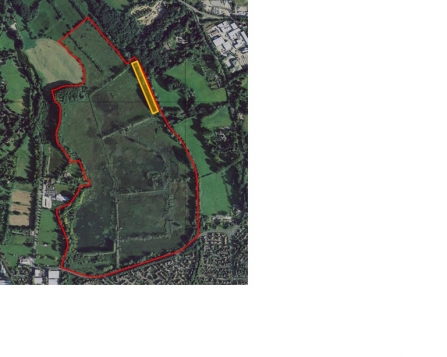
Tree Management Works
Over the next few weeks we will be pollarding and felling a row of non-native grey poplars at Fishlake Meadows nature reserve (marked in yellow on the map).
Poplars reach a point in their lifecycle when they become multi-stemmed and the tree starts to split. Pollarding the trees will reduce the chances of them falling and will increase their lifespan as this allows fresh shoots to grow. Pollarding involves cutting them down to less than two metres in height, then allowing the trees to regrow on a short rotation before cutting them again in approximately ten years’ time.
We are also felling a number of the poplar trees. Several of these trees have fallen in the last few years and therefore it is likely that the rest will continue to fall. This is why we have decided to fell any trees which will be then be exposed, as these will likely suffer wind damage and also fall.
In addition, we are carrying out crown cleaning and canopy reduction of the mature ash and poplar trees within the chestnut paling. This involves removing dead and decaying branches to eliminate the risk of them falling. Reducing the size of the crown and the weight of the canopy reduces the pressure on the tree, making it more stable.
Another reason why we are felling these trees is that the grey poplar trees produce suckers (small branches that come off the root of the tree). This is leading to an increase in scrub and saplings in the open fen adjacent to the trees, and loss of priority wet fen meadow habitat. Furthermore, should the trees fall, the heave of the roots could also damage the canal banks and designated SSSI riparian habitat.
We are carrying out tree works during the autumn and winter in order to avoid disturbing nesting birds. All trees are also checked for likely presence and suitability for bats by a qualified ecologist prior to any works commencing.
The branches of the trees will be stacked nearby, in order to create additional habitat for sheltering bird such as robins and wrens, reptiles such as grass snakes and mammals such as hedgehogs and wood mice. We will also leave standing dead wood in place, in order to provide habitat for saproxylic insects such as beetles.
As part of the process in preparation for the works we have:
- Met with the local TVBC tree officer to discuss the works.
- Had bat surveys carried out looking at roosting and emergence, undertaken by our qualified ecologists. Just prior to the works one further survey of the trees will be carried out.
- Sought and been granted TPO consent from TVBC as the trees are within a tree preservation area.
- Applied for and been granted a felling licence from the forestry commission.
- Followed the European protected species checklist issued alongside the felling licence to ensure all appropriate steps have been followed in the protection of these species.
- A notice of planned works from TVBC has been displayed on the reserve, details of the application for the works made to TVBC planning can be found through their online system ref 18/02197/TPOS.
Benefits
- Remove the risk of the trees falling across the path and damaging the bank.
- Prolong the life of the trees by pollarding them rather than allowing them to fall and die.
- Conserve the wet fen meadow habitat and protect canal bankside habitat
If you have any questions regarding the tree works please get in touch with Jo Iddenden the Reserves Officer at jo.iddenden@hiwwt.org.uk.
Questions:
Why are you pollarding the grey poplars?
Over the last few years, several of the poplars have fallen down across the barge canal path, posing a significant health and safety risk. Grey poplar as a species are quite brittle, so it’s likely more will do the same. The poplars are starting to encroach on the wet fen meadow habitat and where they are growing next to a ditch and bank this could lead to uneven and vulnerable root systems. If the trees were left to fall in their own time, the heave of the roots could damage the canal banks and therefore the canal. The canal is designated a SSSI so we have a duty of care to protect the banks from damage.
Why don’t you only cut the ones leaning towards the path?
Most of the poplars have two stems, one leaning towards the path and one leaning towards the open fen. If we were to only remove the stem leaning towards the path it would put a huge strain on the remaining stem and base and would quite likely lead to the loss of the tree. However, by pollarding both stems and allowing them to regrow will maintain the tree.
Why can’t you leave the ones that aren’t leaning as much?
All of the trees are a similar age, so will have adjusted to having trees close to them as they grew. This means if we were to cut down trees nearby it will expose them to wind pressure they haven’t adapted to, and will make them vulnerable as they aren’t wind firm. By pollarding a number of the trees we will secure their longevity.
